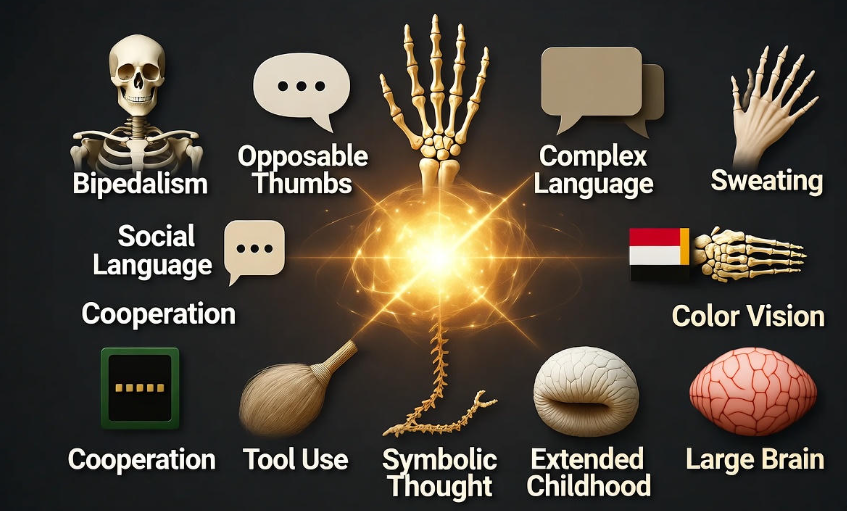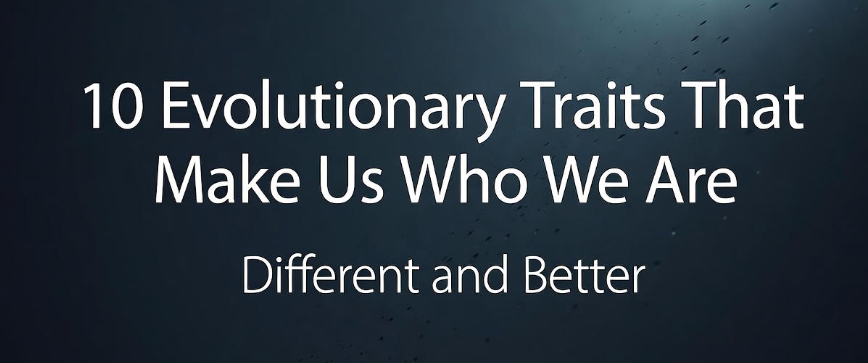Have you ever stopped for a second and thought — why do we behave, think, and even look the way we do? 🤔 It’s fascinating to realize that much of what makes us “human” didn’t just appear overnight. It’s the result of millions of years of evolution, a story written in our DNA. From walking upright to expressing deep emotions, evolution has shaped every little part of us. Let’s explore 10 powerful evolutionary traits that built the amazing species we are today — simple, raw, and truly human.
1. Walking on Two Legs (Bipedalism)
This might seem ordinary now, but millions of years ago, it was a game changer. Our early ancestors decided to stand tall — literally. Walking on two legs freed up our hands for other things: carrying food, using tools, and even holding our loved ones. Imagine trying to survive while walking on all fours — not so practical when you need to hunt or gather.
Bipedalism also changed our body structure. Our spine curved, hips widened, and feet flattened to support upright movement. This one evolutionary trait made us efficient travelers and allowed humans to migrate across continents 🌍. Without it, civilization might never have spread the way it did.
| Benefit | Description |
|---|---|
| Hands freed | Could carry tools, food, babies |
| Energy efficient | Walking upright uses less energy over long distances |
| Broader view | Better visibility to detect threats and prey |
2. Opposable Thumbs — The Original Multi-Tool
Try holding a pencil without using your thumb — tough, right? That’s because our opposable thumbs are one of evolution’s most brilliant designs. This simple joint allowed us to grip, twist, and create.
From carving stones in prehistoric times to typing messages today, this trait made humans makers and creators. It’s no exaggeration to say that without opposable thumbs, there would be no smartphones, no art, and no civilization as we know it. 👍
3. The Big Brain — Intelligence Beyond Instinct
Here’s where things got really interesting. Our brains didn’t just grow in size — they evolved to think, reason, imagine, and plan ahead. Early humans used intelligence to make fire, build tools, and develop language.
But the brain’s growth came at a cost. Larger brains required more energy and longer childhoods to learn survival skills. Still, it paid off — our mental flexibility became our greatest survival tool. 🧠
| Brain Function | Evolutionary Advantage |
|---|---|
| Memory | Helped remember safe foods and dangerous animals |
| Problem solving | Created tools and shelters |
| Social thinking | Built communities and empathy |
4. Complex Language and Communication
Talking isn’t just noise — it’s one of the strongest evolutionary tools we have. Early humans likely started with gestures and sounds, which evolved into complex languages.
Language let us share knowledge, express emotions, and pass wisdom to future generations. Imagine how powerful that was — being able to warn others of danger or teach how to make fire. Communication turned individuals into teams, and teams into societies.
Even today, our ability to connect through words remains the core of human progress. 💬
5. Emotional Intelligence — More Than Just Survival
Humans didn’t just evolve to survive; we evolved to care. Emotional intelligence — the ability to recognize, understand, and manage emotions — became one of our most defining features.
Empathy helped early humans build strong relationships and communities. Those who cooperated had better chances of survival than those who didn’t. So yes, kindness literally evolved as a survival strategy! ❤️
Think about it — love, compassion, guilt, and even jealousy are deeply wired survival mechanisms.
6. Social Cooperation — The Power of “Us”
Unlike other animals, humans thrive in groups. Our ancestors hunted together, shared food, and raised children collectively. Cooperation made complex societies possible.
Over time, this social nature shaped our psychology — we crave belonging. It’s why teamwork feels rewarding and loneliness hurts. We were built for community. 🫂
| Social Trait | Impact on Survival |
|---|---|
| Shared resources | Reduced risk of starvation |
| Collective defense | Protection from predators |
| Emotional bonds | Encouraged care for offspring |
7. Tool Making — The Spark of Human Creativity
When the first human ancestor chipped a rock to create a sharp edge, it was the birth of technology. Tool-making changed everything. It allowed us to hunt better, cut food, and build shelter.
But more than that — it showed imagination. The ability to see something not for what it is, but for what it could become. That creative thinking laid the foundation for every invention that followed — from wheels to the internet. ⚙️
8. Adaptability — The Secret Superpower
From icy glaciers to burning deserts, humans have survived everywhere. Why? Because we adapt.
Unlike animals that rely on fur, claws, or instincts, we rely on problem-solving. We make clothes, build homes, and invent tools to fit our environment. Evolution gave us not fixed traits, but flexibility.
This adaptability continues today — we’ve even learned to live in space! 🚀 That’s the same evolutionary spark that helped our ancestors survive droughts and ice ages.
9. Long Childhood and Learning Period
Humans take years to grow up compared to most animals. Sounds inefficient, right? But that long learning period gave us time to absorb knowledge, social skills, and complex behaviors.
It’s during childhood that the brain forms deep connections — learning language, culture, and emotional behavior. The more time spent learning, the smarter and more capable we become.
So the next time you see a child exploring and asking endless questions — that’s evolution at work. 🌱

10. Imagination and Creativity — The Human Flame
This one might be the most magical of all. Somewhere along our evolutionary path, humans began to dream — to imagine things that didn’t exist. Cave paintings, stories, religion, and later, science — all came from imagination.
It’s this ability to think beyond the present moment that led us to explore, create art, and reach the stars. Our imagination separates us from every other creature on Earth.
| Example | Result |
|---|---|
| Cave art | Expression of thought |
| Storytelling | Knowledge transfer |
| Scientific curiosity | Discovery and innovation |
How These Traits Work Together
These 10 traits didn’t evolve separately — they built upon one another. Walking upright freed our hands → we made tools → our brains grew → we communicated → we formed societies. It’s like evolution designed a perfect chain reaction, leading to modern humans.
Here’s a simple summary table:
| Evolutionary Trait | Key Outcome |
|---|---|
| Bipedalism | Free hands for tools and travel |
| Opposable thumbs | Fine control and creation |
| Large brain | Advanced intelligence |
| Language | Communication and teaching |
| Emotions | Social bonding |
| Cooperation | Community strength |
| Tool-making | Innovation |
| Adaptability | Survival in all environments |
| Long childhood | Complex learning |
| Imagination | Creativity and progress |
A Quick Thought 💭
When we look at all this, it’s humbling to realize that evolution isn’t just about biology — it’s about connection. Every step of our evolutionary story is tied to curiosity, creativity, and compassion.
We didn’t just evolve to exist — we evolved to thrive, to think, to love, and to wonder.
So next time you take a walk, smile at a stranger, or think up a new idea — remember, that’s millions of years of evolution in motion. 🌎✨
Frequently Asked Questions (FAQs)
1. Why did humans evolve to walk on two legs?
Because it allowed us to use our hands for other tasks like tool-making, carrying food, and defending ourselves. It also made long-distance travel more efficient.
2. How did having a big brain help humans survive?
A larger brain helped early humans solve problems, plan ahead, and build tools — which made them better hunters and survivors.
3. Why are emotions considered an evolutionary advantage?
Emotions helped humans bond, cooperate, and care for one another — all of which increased survival chances in groups.
4. What makes human imagination unique?
Unlike other animals, humans can think about things that don’t exist yet — imagining, planning, or dreaming — which fuels creativity and progress.
5. How does evolution still affect us today?
Even today, evolution continues in small ways — through our immunity, adaptability to environments, and the way our brains process modern challenges.
Final Words
Evolution didn’t just give us life — it gave us meaning. Every smile, every invention, every heartbeat is part of an ancient story that began long before us.
We are not separate from evolution — we are evolution. A walking, thinking, feeling miracle shaped by time itself. 🌿💫

Leave a Reply